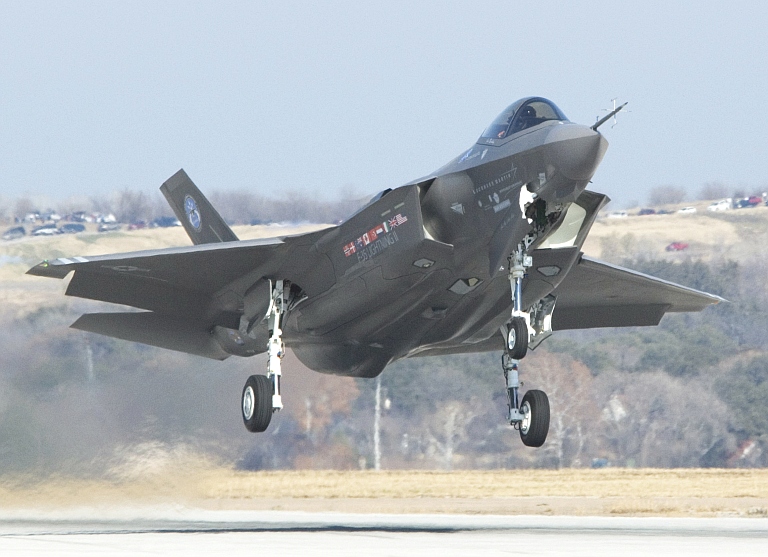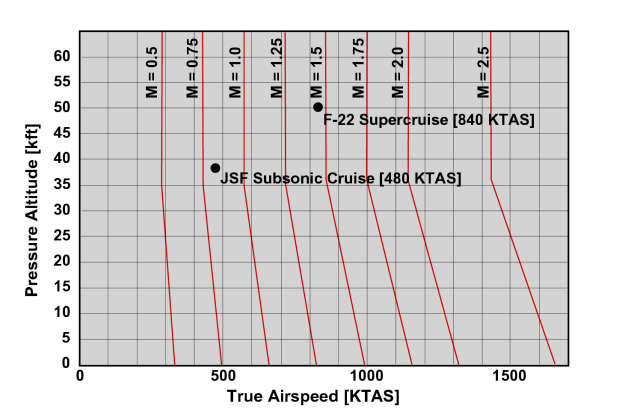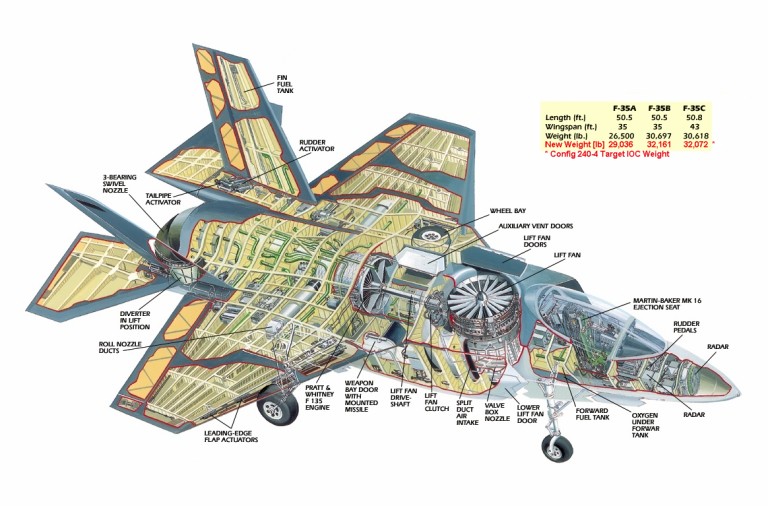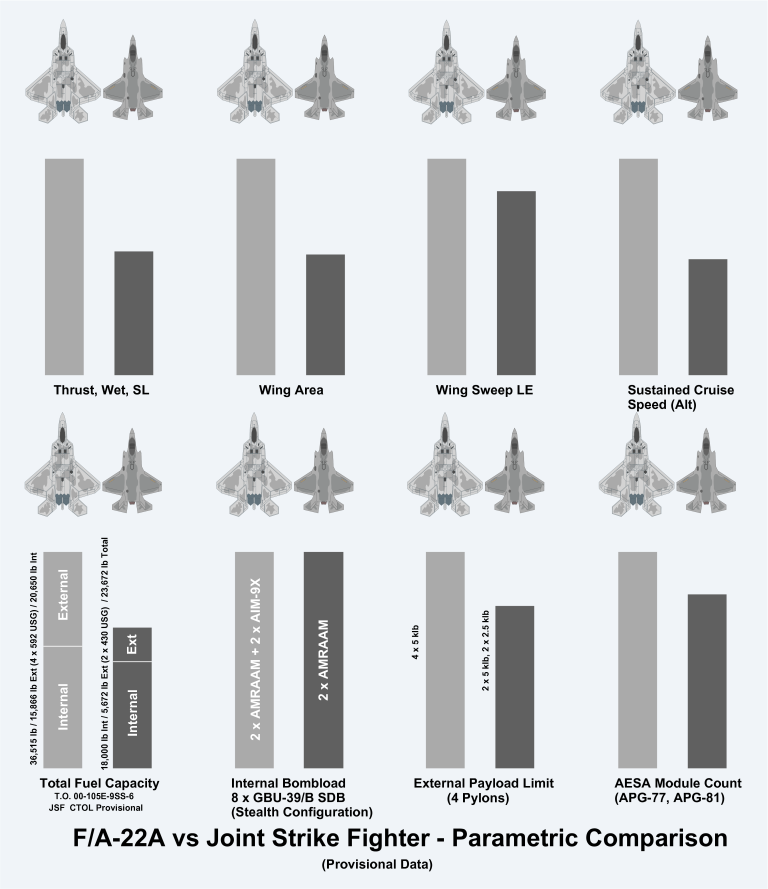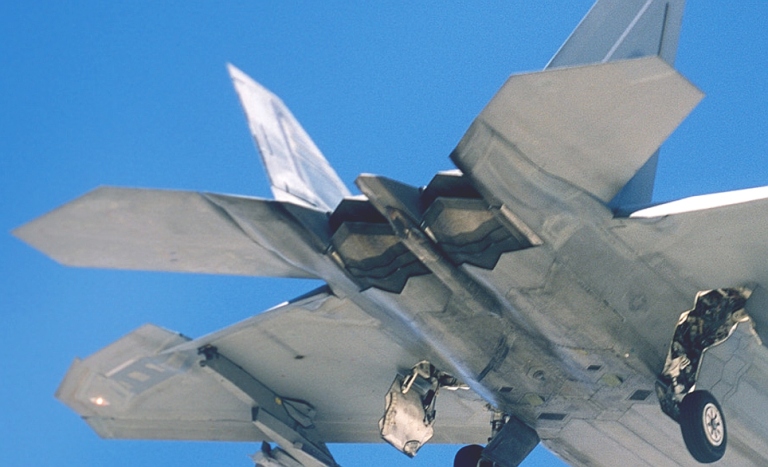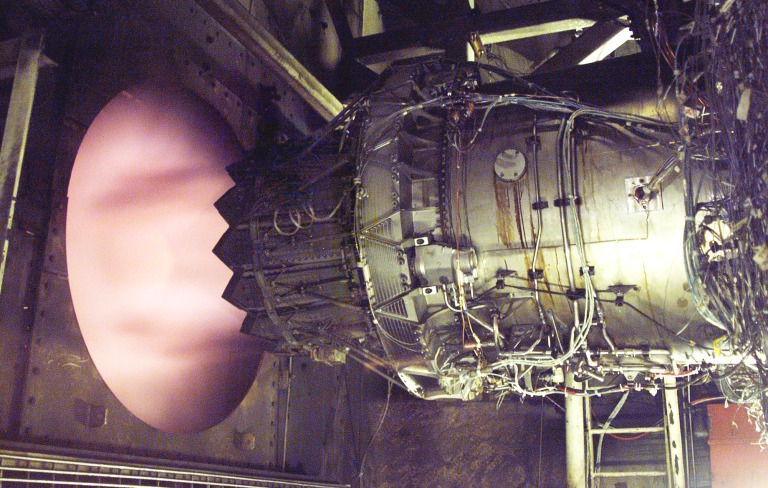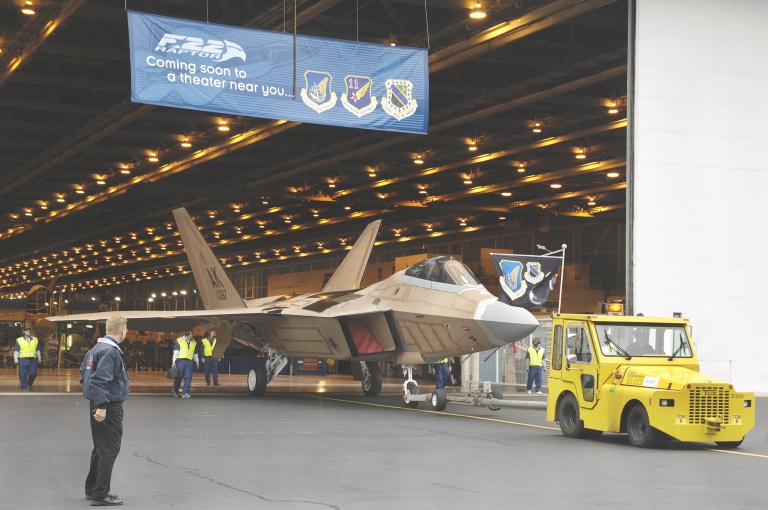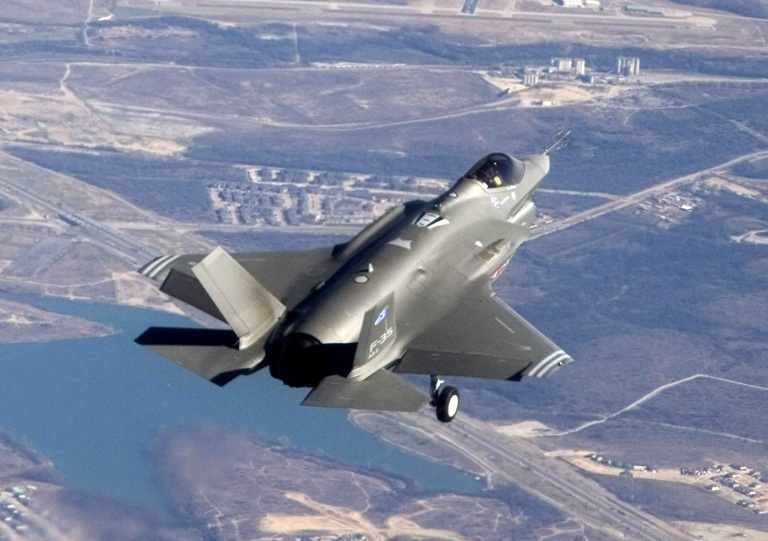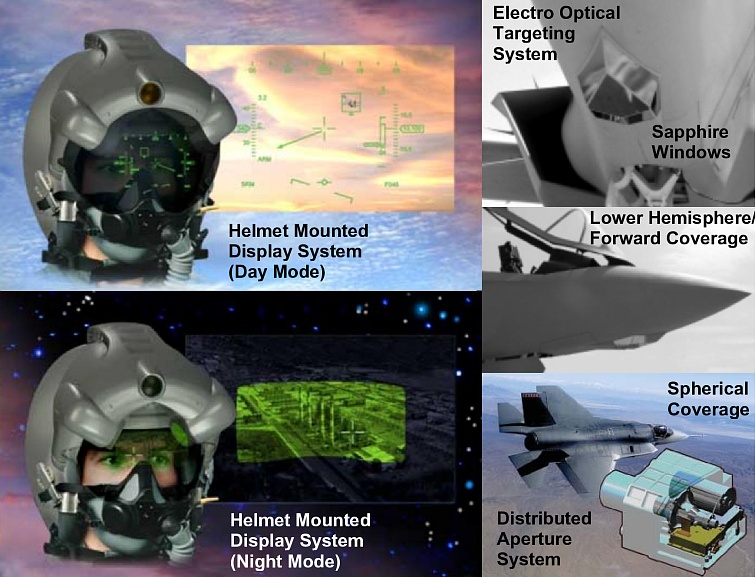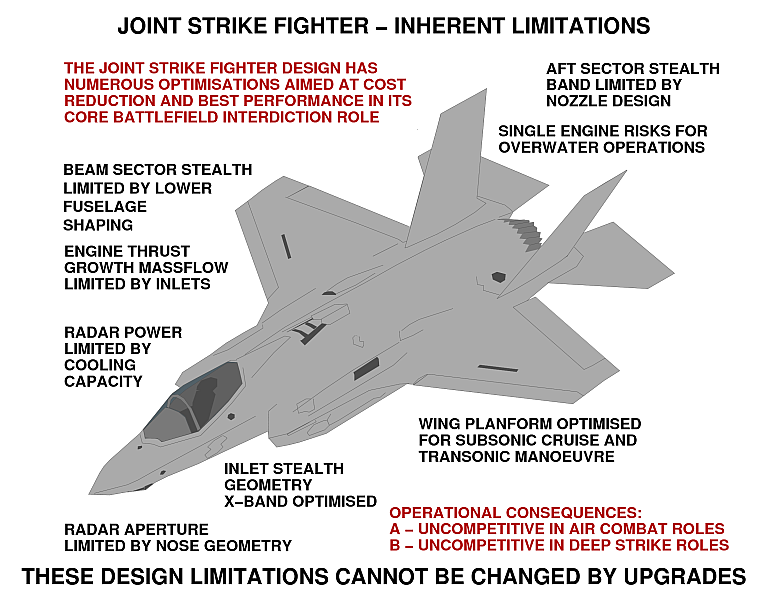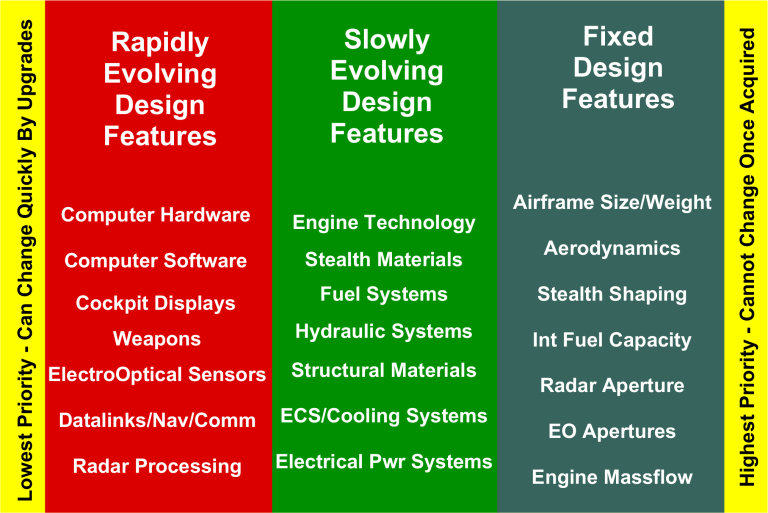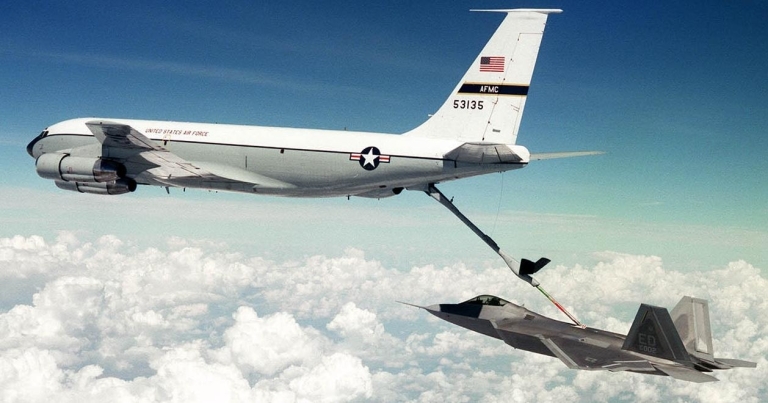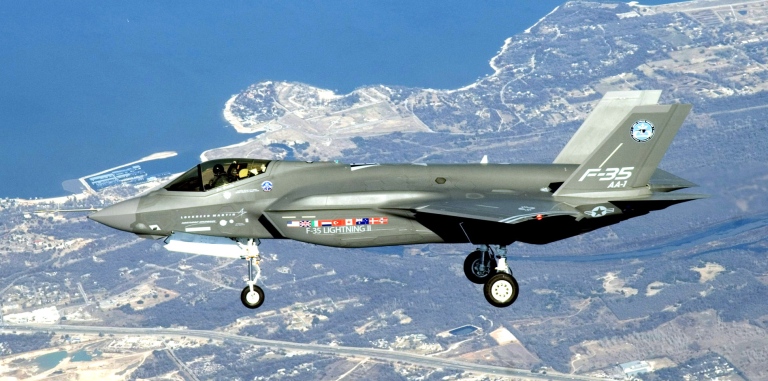|
||||||||||||||||||||||
![Home - Air Power Australia Website [Click for more ...]](APA/APA-Title-Main.png) |
||||||||||||||||||||||
![Sukhoi PAK-FA and Flanker Index Page [Click for more ...]](APA/flanker.png) |
![F-35 Joint Strike Fighter Index Page [Click for more ...]](APA/jsf.png) |
![Weapons Technology Index Page [Click for more ...]](APA/weps.png) |
![News and Media Related Material Index Page [Click for more ...]](APA/media.png) |
|||||||||||||||||||
![Surface to Air Missile Systems / Integrated Air Defence Systems Index Page [Click for more ...]](APA/sams-iads.png) |
![Ballistic Missiles and Missile Defence Page [Click for more ...]](APA/msls-bmd.png) |
![Air Power and National Military Strategy Index Page [Click for more ...]](APA/strategy.png) |
![Military Aviation Historical Topics Index Page [Click for more ...]](APA/history.png)
|
![Intelligence, Surveillance and Reconnaissance and Network Centric Warfare Index Page [Click for more ...]](APA/isr-ncw.png) |
![Information Warfare / Operations and Electronic Warfare Index Page [Click for more ...]](APA/iw.png) |
![Systems and Basic Technology Index Page [Click for more ...]](APA/technology.png) |
![Related Links Index Page [Click for more ...]](APA/links.png) |
|||||||||||||||
![Homepage of Australia's First Online Journal Covering Air Power Issues (ISSN 1832-2433) [Click for more ...]](APA/apa-analyses.png) |
||||||||||||||||||||||
| Last Updated: Mon Jan 27 11:18:09 UTC 2014 | ||||||||||||||||||||||
|
||||||||||||||||||||||
|
Lockheed-Martin
F-35
Lightning
II
Technical
Report APA-TR-2007-0102Joint Strike Fighter Assessing
the Joint Strike Fighter |
|
| by
Dr
Carlo
Kopp,
SMAIAA,
MIEEE, PEng January, 2007 Updated April, 2012 Text, Line Art © 2004 - 2012 Carlo Kopp |
|
|
"Given what is known about both the JSF and F-22A, Department of Defence assertions claiming 'the really big difference is in cost' are little more than nonsense."
Background In late 2003 testimony to the Joint Standing Committee of Federal Parliament on Foreign Affairs, Defence and Trade the Canberra Defence Department leadership asserted that the 'the really big difference [between the F-22A and Joint Strike Fighter] is in cost'. This remarkable statement, and others of a similar ilk, explains much of the euphoria surrounding the Joint Strike Fighter in Canberra Defence leadership circles - the Joint Strike Fighter is incorrectly perceived to be a 'single engine F-22A clone'. Given the design aims, development histories and characteristics of these aircraft, this belief is not supportable by available evidence. This analysis will delve deeper into the differences
between the JSF and its more capable generational sibling, the F-22A
Raptor, and
explore recent developments in the JSF program, with the aim of
separating myth from fact. |
|
|
Resources
|
|
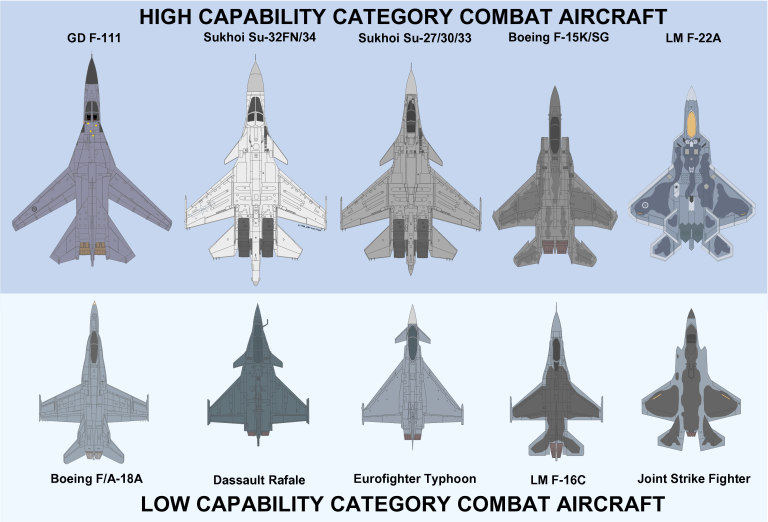 |
|
|
Joint Strike Fighter vs F-22A - A Comparative Assessment Both the JSF and F-22A reflect a process of strategic and technological evolution which began during the 1980s. This was a period during which the Soviet empire reached the peak of its military power before its economic and political collapse, a period during which the high performance Sukhoi Su-27 and Mikoyan MiG-29 entered large scale production, and massive Soviet tank armies presented the benchmark of land power worldwide. During this period the US Air Force relied upon its fleet of F-15A/C Eagle air superiority fighters, supported by the smaller but highly agile F-16A/C, as the means of breaking the back of Warpac air forces in the pivotal Central European theatre. Soviet land forces were to be broken by a mix of F-111, A-7D, A-10A and later, F-16C strike aircraft. The F-15A was primarily aimed at air superiority, although the weapon system supported a range of modes for dumb bomb delivery, used extensively by the Israelis in combat. The enhanced F-15C gained Conformal Fuel Tanks (CFT) to push internal fuel up from 13,455 lb to 23,200 lb, and avionics/engine enhancements. The F-16A was like the F-15A aimed at air superiority, but limited by radar to mostly day VFR combat. While exceptionally agile, the 6,800 lb internal fuel capacity severely limited this aircraft. Growing Soviet air power, especially the new Sukhoi Su-27 and Mikoyan MiG-29, provided the impetus for further air superiority fighter development. The US Air Force launched the Advanced Tactical Fighter (ATF) program aimed at replacing the F-15 with an aircraft providing an overwhelming capability margin over the Su-27/MiG-29 - similar to that held by the F-15A over the MiG-21 and MiG-23. A key feature of the ATF was the addition of a supersonic cruise or 'supercruise' capability - the ability to remain supersonic on dry thrust as long as the fuel payload permitted. Supercruise was intended to provide an unbeatable total energy advantage over fighters with conventional propulsion which are limited to mere minutes in full afterburner before exhausting their fuel. A side benefit was the ability to transit from runways in Holland and the UK to the FEBA in half the time the F-15 required. Considerable R&D investment was made very early into the supercooled turbine engine technology required to support this regime of flight - stealth became a feature of the ATF program only after the F-117A proved to be viable. The ATF flyoff saw the stealthier, more agile and faster Northrop/MDC YF-23A pitted against the Lockheed/Boeing/GD YF-22A, with P&W and GE bidding their respective YF119 and YF120 engines. By 1991, the respective winners were the Lockheed led team and P&W, in a large part due to their more conservative and thus lower risk designs. The then YF-22A ATF had evolved into the technological flagship of the 4th/5th generation fighter class - now embodied in the technologies in the F-22A and JSF. The F-22A aircraft, now known as the Raptor, has supersonic cruise engines, thrust vectoring, all aspect stealth capability, a large active phased array radar, and the innovative Pave Pillar avionics architecture, which shifted all signal and data processing into a group of centralised multiple processor chip computers. It is an all weather, day/night, 24/7 air dominance air combat capability aircraft which, by definition, is multi role. As the Soviet empire collapsed the role of the F-22A evolved
to encompass the 'deep strike' role of the current F-117A (and earlier
the F-111) - destroying heavily defended ground targets using smart
bombs. With the current phase out of the F-117A, the Holloman FW will
be one of the first to deploy the Raptor. The 250 lb class GBU-39/B Small Diameter Bomb came into existence as a weapon to increase the internally carried firepower of the F-22A, limited then to a pair of internal 1,000 lb GBU-32 JDAMs, as well to address the increasing rules of engagement and laws of armed conflict based pressures for minimising collateral damage. The current F-22A is a genuine multirole fighter, with high resolution Synthetic Aperture Radar capability and to be tasked as much with air superiority as with killing SAM sites, radars, airfields, bunkers, command posts and other high value assets. The planned US Air Force Global Strike Task Force (GSTF) will comprise 48 F-22As and a dozen B-2As and is intended to break the back of any opponent, globally. Penetrating defences at 50,000 ft and sustained supersonic speeds, the F-22A defeats most SAMs by kinematic performance alone - its stealth capability defeating the top tier S-300/S-400 series systems. The F-22A will remain the most survivable strike fighter in existence for decades to come - and the most lethal air superiority fighter. The JSF evolved from a completely different set of needs and strategic pressures, and occupies a completely different niche in the US force structure. While the JSF program has its origins in the early 1990s, the philosophical thinking in many of its key design features dates to a similar era to that of the ATF program. The problem of breaking Soviet ground forces increased in difficulty during the 1980s. As the Soviets introduced night vision equipment on tanks, and fielded the highly mobile SA-12 (S-300V), SA-11 (9K37), SA-15 (9K330) battlefield air defence weapons, it became evident that the existing fleet of A-10A and A-7D close air support and battlefield interdiction (CAS/BAI) aircraft would be hard pressed to survive, let alone provide the numbers to break the Soviets in the Fulda Gap. While the USAFE F-111E/F deep strike force was being supplemented with 200 of the new Dual Role Fighter (F-15E 'Beagle') and the 60 F-117A stealth fighters, Tactical Air Command's CAS/BAI force was sorely in need of improvement. A fly-off was started between an upgraded A-7D Corsair II, the YA-7F with the F-16's P&W F100 afterburning fan, and an enhanced F-16B variant. Concurrently, trials commenced with dual seat YA-10Bs fitted with the then new LANTIRN package of pods - one pod carrying a terrain following radar and look into turn steered thermal imager, the other laser / thermal imager pod most akin to a miniaturised Pave Tack. This ambitious plan for enhancing the CAS/BAI fleet collapsed as the Soviets collapsed, but important lessons were learned, all reflected now in the JSF program. The A-7F was found to have inadequate fuel capacity for the role though its mildly supersonic speed was suitable, while the A-10A's low speed remained a problem. The F-16 equipped with the LANTIRN system was found to be cumbersome - the pod set was designed for the deep strike F-15E / F-16E (XL) intended for strikes on prebriefed targets rather than searching for difficult to spot ground targets in proximity to friendly troops. Perhaps the most significant technology then trialled on the F-16B was a head steered thermal imaging turret mounted in front of the windshield. This was found to be very effective, as the pilot could look around the aircraft, in any direction, to find targets and spot incoming SAMs and gunfire. In conventional low level close support work, fighters ended up orbiting the area of interest while ground Forward Air Controllers relayed the enemy force position. Being able to look over the shoulder to locate targets proved invaluable. This experience was prominent in the minds of US force planners during the early 1990s, as the JSF was born, and LANTIRN equipped F-16CGs absorbed the role performed by the A-7D. The A-10A soldiered on, only recently acquiring Israeli built Litening II targeting pods. During this period the US Air Force deep strike fleet retained the F-111F, the new F-15E and the stealthy F-117A, backed up by the B-52G/H, and the new B-1B and B-2A heavy bombers. The then recent Desert Storm campaign illustrated that the key weakness in the force structure was the battlefield strike fleet - not only was the survivability of the slow A-10A a problem, but the range/endurance of the F-16C was inadequate even for the modest 400 to 600 NMI radius needed. The US Navy and Marines experienced similar troubles with the F/A-18s, while the Marines' AV-8B Harriers suffered disproportionate losses to heatseeking SAMs. As the JSF program materialised from the JAST technology demonstration effort, each of the respective US players brought their own wishlists to the table. The US Air Force wanted a better CAS/BAI package than provided by the existing mix of F-16CG and A-10A, one which absorbed all of the valuable lessons of the late 1980s and Desert Storm. This meant more fuel and weapon stations than the F-16C, stealth optimised to beat radar guided battlefield SAMs and AAA, all round night vision to improve survivability against ground defences and the ability to find immediate ground targets hidden from the view of a FAC. The F-16 community insisted on good close-in air combat capability - a hedge against enemy fighters breaking through top cover CAP defences. While early proposals were devoid of an expensive radar, intended to rely on ground target coordinates provided by E-8 JSTARS, UAVs and satellites, the demand for air combat capability and more autonomy saw this idea die very quickly. The politically vocal and influential US Marines wanted a replacement for their F/A-18s and AV-8B Harriers, which meant a V/STOL capability, but faster and more survivable. The Marines, like the F-16C community, insisted on close-in air combat capability, and wanted an all weather day night avionic package better than their two seat F/A-18D fleet had. Tasked with close air support, the Marines needed an aircraft capable of surviving SAM and AAA defences at low level, and capable of autonomous target acquisition, in the absence of capabilities like the E-8 JSTARS. The US Navy at that time suffered significant losses in the budgetary game. The A-12A Avenger II (Dorito) died at the hands of DepSec Cheney, in an acrimonious dispute over performance and price, leaving them without a replacement for the deep strike A-6E Intruder fleet. With much investment in a collapsed A-6 upgrade and the A-12A avionic suite, the Navy wanted a bomber which could absorb as much as possible of the capability planned for the A-12A. What is significant is that the US Navy had a large investment in air-ground radar technology. The capability for simultaneous Synthetic Aperture Radar (SAR) high resolution groundmapping and Ground Moving Target Indicator (GMTI) mobile target tracking had its origins in a Norden radar planned for the A-6, and later becoming the basis of the APG-76 radar fitted to Israeli F-4Es. This capability was to be absorbed in the A-12A's active phased array which also collapsed. It has rematerialised now in the JSF's radar system - the higher power rating of this radar against the F/A-18 radars reflecting the power-hungry GMTI mode. These diverse needs coalesced in the JSF program, which attempts to reconcile them with further and much broader aims. The stated service needs for the JSF are thus (JSF website):
All three primary users plan to fly their JSFs with stealthy internal weapons during the initial phase of a conflict, shifting to larger payloads of non-stealthy external weapons once the primary radar directed air defences are broken. Two other factors had a decisive influence on the JSF as we see it today. The first is that much of the avionic, stealth and engine technology first seen in the F-22A program was absorbed, but adapted for higher volume production and lower costs where achievable. The second was the adoption of a Cost As an Independent Variable (CAIV) design philosophy, intended to trade off capabilities and performance as required to achieve very ambitious cost aims - the simplest US Air Force model was originally to come in at US$38M unit flyaway cost each, including ECO and non-recurring costs. The common thread running through all of the US service roles is a primary strike optimisation, reflected in the avionics and airframe design of the aircraft. Single service roles have been clearly traded down to achieve commonality. The JSF will not provide the payload-radius of the Navy A-6/A-12A deep strike aircraft, nor will it provide the relative agility advantages of the Air Force F-16A against its original Soviet opponents. The aircraft has a more complex and expensive avionic suite than would be required for any of the single service roles, as it rolls all three requirements into one package. The JSF's stealth capabilities are more narrowly optimised than those of the F-117A and F-22A, reflecting the need to survive mobile battlefield and littoral defences rather than penetrating an Integrated Air Defence System in depth. The JSF is thus a radically different aircraft to the F-22A, in its primary design aims, capabilities and performance. Against its mid 1990s role definitions, the JSF is a very good fit, but with the evolution since 2001 toward persistent battlefield strike tactics, the JSF falls short in both fuel capacity and weapon payload. Were the JSF defined and sized today, the CTOL/CV variants would be larger twin engine fighters closer in size to the F-111 - the only viable commonality with the VSTOL roles would be in avionics and engine cores. While the CTOL/CV JSF carries an 18,000 lb class and the F-22A a 20,650 lb internal fuel load, the now 29,000 to 32,000 lb class empty weight JSF at design configuration 240-4 employs a single engine rated in the 40,000 lbf wet thrust class, against the F-22A's pair of 35,000 lbf wet thrust class engines, the latter totalling 70,000 lbf. This results in an enormous difference in achievable thrust/weight ratio, both dry and wet, as the much larger and and only marginally heavier F-22A has almost twice the engine thrust available. Engine optimisations are also quite different, as the JSF's F135 uses a larger low(er) altitude optimised fan, compared to the high altitude optimised fan of the F-22A's F119-PW-100. The JSF trades away high altitude supersonic engine performance to achieve better cruise and loiter burn, and extract as much thrust as possible at lower altitudes, essential for its primary design role of battlefield strike. The design optimisations of the 460 sqft (CTOL/STOVL) and now 668 sqft (CV) JSF wings and the 830 sqft class F-22A wing also differ radically. With a leading edge sweep of around 34 degrees, the JSF wing sits between the F-16 and F/A-18, and is nearly identical to the battlefield strike optimised A-7D/E series. The F-22A's wing at around 40 degrees sweep is closer to the F-15 and Su-27/30 series - a tradeoff between supersonic drag and turning performance. Unlike the F-22A which is designed around supersonic agility, the JSF wing trades away supersonic performance to maximise subsonic cruise/loiter efficiency - classical bomber optimisation rather than air combat optimisation. The basic aerodynamic and propulsion optimisations of the JSF
against the F-22A reflect their original airframe design aims - the
F-22A to kill other fighters and penetrate air defences at supersonic
speeds, the JSF to hunt battlefield ground targets, and evade missiles
and fighters. Like the F-15, the F-22A can be swung to strike roles
without sacrificing its supersonic performance, but the JSF's wing and
engine optimisations preclude it from ever achieving high supersonic
performance, vital for running down supersonic opponents like the
Su-27/30, or supersonic cruise missiles, or supersonic cruise missile
launch platforms like the Tu-22M3 Backfire. The stealth design optimisations of the F-22A and JSF also differ markedly. The deep penetration and air dominance roles of the F-22A dictated all aspect capability, resulting in the expensive edge aligned thrust vector nozzle design, which provides good 'wideband' frequency capability. The JSF is optimised for best stealth in the forward sector, sharing general airframe shaping rules common to the F-22A. The notable difference is in the serrated edge circular nozzle of the JSF, which is clearly optimised for best performance in the X and Ku-bands, typical of fighter radars, SAM/AAA tracking systems and missile seekers. To achieve lower costs the JSF accepts notable aft sector stealth limitations, especially when tackling deep or layered air defences with fighter threats - an acceptable tradeoff for shallow littoral and FEBA area battlefield strikes against predominantly short range mobile air defence systems. The aim in the JSF is to use newer materials technology than the F-22A does to reduce stealth costs, although we are likely to see this technology migrate across to the F-22A in later blocks. The core avionic systems of the JSF and F-22A share a common architectural model - sensors are 'dumbed down' and signal/data processing is migrated from specialised hardware to software running on general purpose high performance computer processors in central processing boxes. This very powerful model permits rapid evolution in signal and data processing techniques, within the limitations imposed by the sensors used to gather information. Both the F-22A and JSF are to now use cheaper commercial processing chips and optical bus technology. The distinctions in onboard computing power between both types will be given by the immediate block upgrade configuration at that time - both using multiple COTS PowerPC chips. The sensor suites of both fighters differ strongly, reflecting their different roles. The F-22A's APG-77 active array radar with 1500 modules of higher power rating than the 1200 module APG-81 radar of the JSF achieves significantly better detection range against airborne targets, and by default greater stand-off range in SAR groundmapping - and any growth GMTI/MMTI modes. The APG-77 also has growth provisions for sidelooking cheek arrays. The JSF APG-81 radar is conversely designed around simultaneous SAR/GMTI strike capability, but providing air-air detection capabilities much better than the F/A-18A-D and F-16C-F. The fundamental differences between the radar packages lie not only in the F-22A's much superior air-to-air range performance, but also in their long term growth potential. While radio-frequency modifications and software growth permit the APG-77 to acquire the capabilities in the JSF APG-81, the JSF's nose size, power generation capacity and cooling capacity will set limits on the achievable air-air and air-ground range growth in the JSF. Recent reports indicate that a second generation F-22A antenna, using common modules to the JSF but of higher power rating, will be phased into later block production of the F-22A. The passive electronic detection suites in both aircraft differ, although few details have been disclosed. The JSF system is claimed to incorporate a passive emitter location capability (passive rangefinding of threat radars), effectively absorbing the role of the F-16CJ. Given the F-22A's demand for higher operating altitudes and threat radar geolocation for deep penetration, we can safely assume that its ALR-94 passive detection system will be much more sensitive - the radar horizon at 50,000 ft is much further away than at 25,000 ft. The F-22A was to have been fitted with the Advanced Infra-Red
Search and Track (AIRST) system, provisioned for in the avionics. This
has not materialised as yet for funding reasons. The JSF on the other
hand is equipped from day one with two optical systems - the
Electro-Optical Targeting System (EOTS) and the DAS (Distributed
Aperture [InfraRed] System). The EOTS is a repackaged growth derivative of the latest LM
Sniper XR laser / TV / thermal imaging pod, fitted inside a faceted
sapphire window chin fairing. It will provide TV and midwave IR imaging
with multiple fields of view, and increased range laser designation and
ranging capability over most existing podded systems. The JSF's DAS is a radically new idea, using six fixed thermal imagers to provide spherical coverage around the aircraft, and digital processing to provide not only missile threat warning, but also a look anywhere Helmet Mounted Display System (HMDS) capability for the pilot. The DAS combines the ideas trialled in F-16 head steered FLIRs for battlefield strike, with an all aspect IR Missile Approach Warning System (MAWS) capability - the latter reflecting ongoing losses of A-10s and AV-8Bs to low level IR MANPADS and mobile SAMs. While an EOTS equivalent for the F-22A has been repeatedly discussed in the US press, it is unlikely to be added until later blocks due to existing cost caps. The JSF cockpit is newer technology to that of the F-22A,
using a single panel redundant projector rather than individual AMLCD
display panels. Production cost pressures may see the JSF display
technology absorbed in later blocks of the F-22A. Integrated
capabilities for networking with other platforms are similar for both,
driven by the need for intra-type, and intra and inter service
interoperability - with the caveat that the larger sensor footprint of
the F-22A makes it a very much better 'information gatherer' compared
to the JSF.
The weapons capabilities of the F-22A and JSF are similar, but the JSF is designed to carry larger 2,000 lb JDAMs internally, cf the F-22A's 1,000 lb JDAMs. Both carry eight GBU-39/B Small Diameter Bombs internally - an equal payload of the 'standard' new smart bomb. With eight internal GBU-39/B each, the F-22A carries 2 x AMRAAM and 2 x AIM-9X, while the JSF is limited to only 2 x AMRAAM internally. The JSF has yet to demonstrate clearance of any weapons from its internal weapon bay, which due to near field aerodynamics and the canted / toed-in carriage of large stores in the bay, will present a number of risks for the program. From a 'bombing productivity' perspective, armed with the GBU-39/B, supercruise in the F-22A provides a unique advantage. At ranges where the transit time between runway and target dominates the sortie duration, the ability of the F-22A to cruise supersonic at nearly twice the subsonic cruise speed of the JSF permits it to perform more sorties - at some range this becomes twice as many sorties, effectively doubling the 'bombing productivity' of the F-22A vs the JSF. Both aircraft are equipped with external wing pylons to carry
external weapons and/or fuel in scenarios where stealth is no longer
required, and both will suffer range penalties due to external stores
cruise drag when carried. The F-22A has four jettisonable pylons with
paired AMRAAM rail launchers, each rated to 5,000 lb, the JSF four
pylons, inboard at 5,000 lb, outboard at 2,500 lb, with further
outboard auxiliary pylons rated at 300 lb for AAMs. An external stores
pod was in development for the F-22A, which would allow the stealthy
external carriage under the wing of up to four 2,000 lb class external
stores such as the JDAM. While the JSF is funded for some external air-ground stores
clearances, at this time the F-22A remains limited to external tanks
and air-air missiles due to the funding cap. With similar subsonic
cruise range performance given similar internal fuel, both types will
require generous tanker support in stealthy air-air and strike regimes
of operation. Neither can compete with the F-111 in the payload radius
game.
In comparing the JSF and F-22A in air-combat roles, the F-22A is vastly superior. In long range BVR combat the F-22A has major advantages in sustained energy performance, stealth, radar range and missile kinematic performance - an AMRAAM goes a lot further if launched from twice the altitude at supersonic speed. In close in combat the F-22A's greater agility cannot be contested - on dry thrust the F-22A outclimbs and outaccelerates an afterburning F-15. The JSF is designed to achieve similar performance to the F-16C, itself inferior to the F-15 series. In any Combat Air Patrol scenario, supercruise permits the F-22A to cover four times the footprint of a JSF. It can engage and disengage opponents at will, unlike the slower and less stealthy JSF. The F-22A outclasses the JSF across the board and is several times as effective in most air combat regimes. In comparing the JSF and F-22A in strike roles, the divergent
deep strike optimisation of the F-22A and battlefield strike
optimisation of the JSF are telling. The F-22A is much more survivable
as it is stealthier and supercruising. However, the F-22A in its
current configuration lacks the extensive electro-optical suite and
radar modes of the JSF, required for battlefield interdiction and close
air support. The JSF will have better loiter performance, especially at
low altitudes, and carries a larger internal bomb payload, where these
are JDAMs, but identical where these are the SDB. Yet on long
range strike profiles, the F-22A achieves similar 'productivity' in
bomb deliveries as the JSF as it can transit to and from targets almost
twice
as fast, both requiring generous tanking to achieve F-111 class strike
radii or on station persistence. The Canberra DoD has consistently misrepresented
the strike capabilities of the F-22A, to the extent of sheer absurdity.
The US are currently phasing out their primary deep strike asset, the
F-117A Nighthawk, and will be replacing the fleet of 50+ F-117As with
around 40 F-22As. The planned Global Strike Task Force is also
structured around the strike capabilities of the F-22A. The simple
reality is that the US would not be making such deep force structure
changes, all of which pivot around the strike capability of the F-22A,
unless its capability was considered to be very robust. It is worth
observing that the replacement of the F-117A by F-22A has been policy
since the late 1990s and on the public record for nearly nine years, at
this
time. Claims by the Canberra DoD that the JSF can carry a wider
range of strike weapons rely on their target audience not knowing that
the only two weapon types funded for the JSF which are not planned for
the F-22A are the AGM-154 JSOW gliding cluster weapon - a class of
weapons not used in Australia due to policy - and the legacy Paveway
series laser guided bombs. Given that the bureaucratic view of the F-22A's strike
capabilities is so completely at odds with public knowledge, and been
publicly rebutted by so many analysts, it is remarkable that the
Canberra DoD continues to propagate this canard publicly. In comparing the JSF and F-22A in Intelligence Surveillance Reconnaissance (ISR) roles, the F-22A does much better for a number of reasons. Both aircraft will have a respectable capability for high resolution SAR ground mapping and electronic intelligence gathering built in - adaptation for ISR requires an internal digital recorder and datalink transmit capability, neither expensive. High quality optical and thermal imaging reconnaissance would require specialised payloads for both types - the JSF EOTS is not competitive against even current multi-Megapixel focal plane imagers, and the same would be true of any equivalent system used in the growth of the F-22A. Payloads such as thermal imaging strip mappers, visible/IR digital framing cameras and hyperspectral imagers would have to be carried in the internal bays of these aircraft. In this respect the F-22A's Sidewinder bays are much better situated geometrically, compared to the JSF's main ventral bays, permitting oblique imaging without a stealth reducing faceted bay door bulge. In the ISR game, timeliness and survivability are top considerations, and the supercruising F-22A wins this game without question. Future ISR payloads are likely to evolve for both types as depot fit weapon bay payloads, with additional software added. In comparing overall evolutionary growth potential, the F-22A
wins decisively over the JSF. A plethora of historical case studies of
multirole aircraft indicate that the two decisive drivers of evolution
into alternative roles are size and raw aerodynamic performance. The
F-22A with a larger airframe, wing, internal volume, radar bay, total
engine/electrical power and better stealth design has an unassailable
lead. This is true for a comparison of the basic F-22A vs the basic
JSF. A point of major concern expressed by most analysts is the paucity
of volumetric, power and cooling capacity for growth in the JSF over
its intended life cycle. An unknown at this time is the deep strike FB-22A derivative proposal - an 'F-111 like' deep strike optimised F-22A derivative. This paper aircraft uses an F-22A fuselage and tail section, with a large fuselage plug and a highly swept delta or cranked arrow wing planform. Designed for 1,000 NMI class radius supercruising strikes, the FB-22A is a 'new technology F-111' intended to fill exactly that niche, but with potential to be a long range/endurance interceptor and deep escort for the B-2A. Comparing unit flyaway costs of the F-22A and JSF is complex, insofar as technology migration from the high volume JSF into the lower volume F-22A could significantly impact next decade cost structures. At this time likely candidate technologies will be antenna modules, computer components, internal data networking, engine hot end components, stealth materials and production processes especially for composite parts. Build volumes for both types longer term remain unclear, as the US Air Force wants more F-22As more than it wants extra JSF numbers, while JSF numbers for Navy, USMC and export are likely to decline if current trends continue. The current US Air Force contracted build for 185 aircraft,
arbitrarily cut by former SecDef Rumsfeld from 287 to 332 F-22A
aircraft, that itslefed capped by Congressional edict. Lobbying
continues for
an
increase to at least 381 aircraft, and ultimately 500 plus. This
follows the
historical pattern seen with the F-15A-E. Unit flyaway costs at the end
of the current build are expected to be in the US$90M to $100M bracket,
with downstream technology insertion favouring the lower numbers. With
follow-on builds, the numbers are likely to fall into the US$75M to
$85M
bracket. It is worth noting a propensity
in some Canberra circles and by the Canberra DoD to
consistently misrepresent the F-22A 'program' unit cost which includes
the total procurement costs plus amortisation of the already sunk
R&D expenses as the unit procurement cost or price for the Raptor,
resulting in grossly inflated and sensational numbers, particularly
when compared with the 'average unit recurring flyaway cost in 2002
dollars' religiously used by the Canberra DoD when asked what
the JSF will cost. The JSF has seen a steady growth in its target costs over time. Early in its evolution is was to cost the same as an F-16C, but that soon crept up to US$38M for the cheapest basic (CTOL) model and by 2002 US reports indicated circa US$50M. Now many US analysts predict an 'average unit recurring flyaway cost' in the US$65M to US$70M bracket with the Congressional Research Services reporting in early 2006 an average unit procurement cost of US$94.8M. Where the cost of the JSF ends up will depend on a range of technological factors as well as total build numbers. Since the JSF Program is still not at the mid point of the system development and demonstration (SDD) Phase and, therefore, on the back side of the development risk hump or curve, there is a medium high to high probability that the costs will gain some considerable altitude before levelling off into the Production Phase. Early to mid low rate initial production (LRIP) units are already being budgeted in the current FY2008 Defense Budget Proposal to Congress to cost between US$224.6M (in 2009) and US$134.5M (in 2013) per aircraft. A mature production F-22A in the 2015 timeframe, one which has
absorbed avionic, engines, materials and production technologies paid
for by the JSF program, will incur its principal production cost
differences against the JSF in additional structure, and an additional
engine/nozzle. The order of magnitude difference in cost between mature
JSF and F-22A could be around US$10M to 15M flyaway - this estimate
fitting very closely to cited flyaway numbers for F-22As post the
current build number cap, vs the more conservative JSF estimates. If
the then JSF comes in at 50 to 75 percent of the flyaway/FMS cost of
the then F-22A, buying the much less capable JSF would be a folly. Given what is known about both the JSF and F-22A, Canberra Department of Defence assertions claiming 'the really big difference is in cost' are little more than nonsense. |
|
|
While nominally both
stealth fighters, there are important
distinctions in stealth performance between the F-22A and JSF. To save
weight and costs, the JSF will use a narrowband serrated circular
engine nozzle (below), as compared to the highly stealthy wideband
edge
aligned thrust vector nozzle used in the F-22A (bove). This reflects
the
F-22A's roles of air superiority and penetration of heavy air defences,
against the JSF's main role of battlefield interdiction and close air
support.
|
|
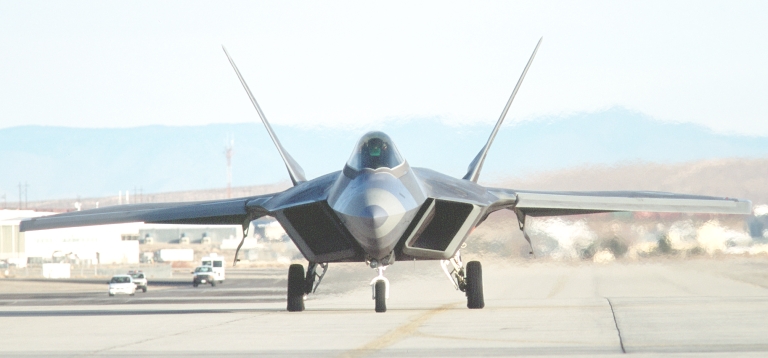 Both the F-22A (above) and JSF (below) use similar planform alignment and stealth shaping rules, reflecting a common design heritage. In the critical forward sector, the much more refined design of the F-22A is evident especially in the edge aligned inlet configuration and cleaner chining. The F-22A scatters into a smaller number of lobes over a much wider frequency band, reflecting its all aspect wideband stealth requirement. 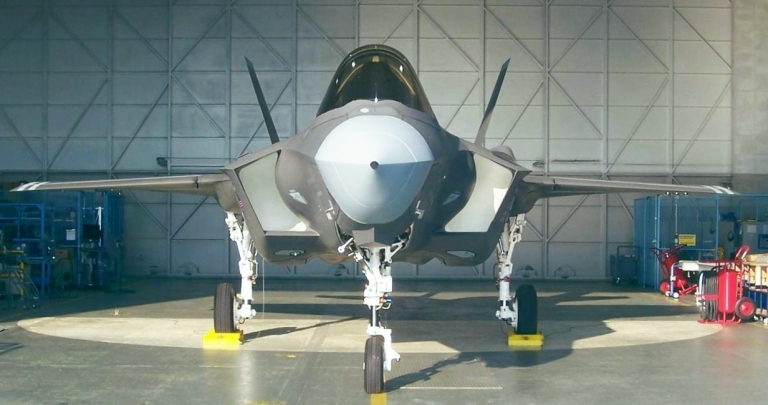 |
|
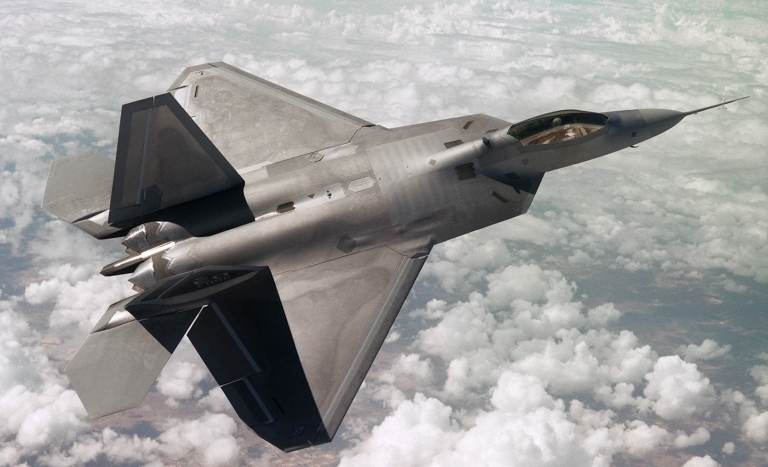 Side by side the aerodynamic differences of the F-22A (above) against the JSF (below) are prominent, especially the larger wing area, larger tails, larger leading edge sweep angle, and high alpha inlet configuration. The F-22A is built for supersonic cruise and high G manoeuvre, distinct from the JSF which is built for subsonic cruise and supersonic dash only. The F-22A on dry thrust alone outperforms an afterburning F-15C, whereas the JSF is designed around the agility and manoeuvre envelopes of the 1970s era F-16 and F/A-18 - both then inferior to the F-15 family. 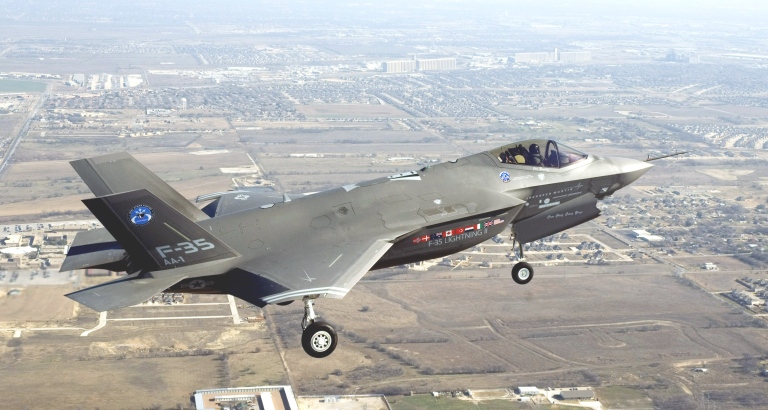 |
|
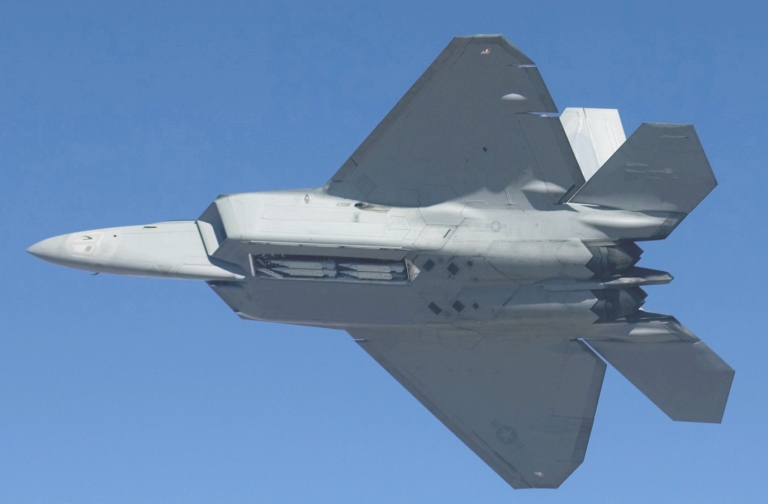 The new 285 lb Boeing GBU-39/B is the weapon of choice for stealthy strikes on battlefield, urban or other smaller targets. The JSF carries eight weapons internally, with growth up to twenty - the F-22A also carries eight (depicted, flight test), with growth to twelve weapons (Boeing/LM). 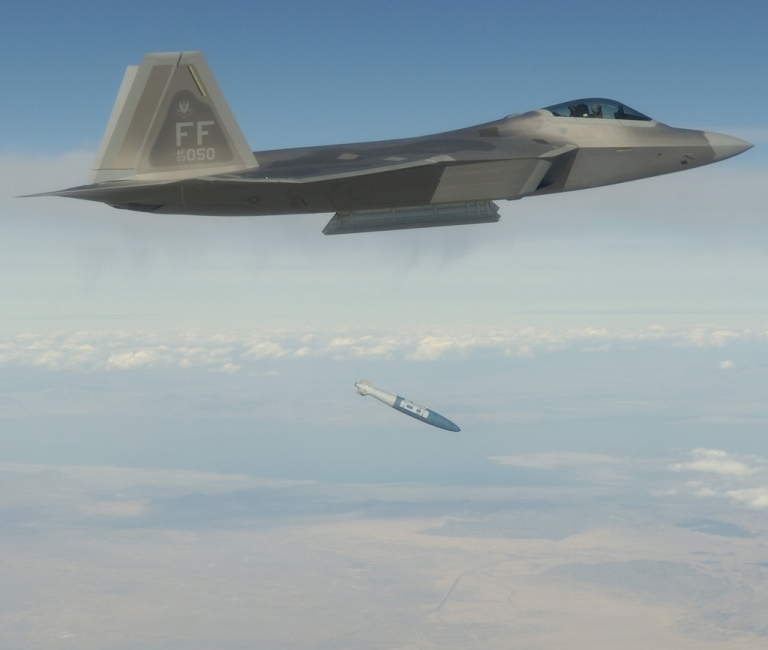 F-22A
Raptor assigned to the 27th Fighter Squadron of the
1st Fighter Wing, Langley, Virginia, the first operational unit to fly
the F-22A, releasing a GBU-32 JDAM satellite/inertial smart bomb. The
US Air Force intends to replace the F-117A Nighthawk stealth fighter
with the F-22A providing a precision strike capability against the most
heavily defended targets. Two F-22A squadrons are to be assigned to the
49th Fighter Wing at Holloman, New Mexico, replacing all existing
dedicated F-117A strike aircraft. Since
the F-22A was conceived during the 1980s, its basic role has expanded
considerably. Early production F-22As will be used both as a
penetrating strike fighter and air combat fighter, and medium term
planning envisages an Intelligence Surveillance Reconnaissance role,
Suppression of Enemy Air Defence role, and an Electronic Attack
derivative.
|
|
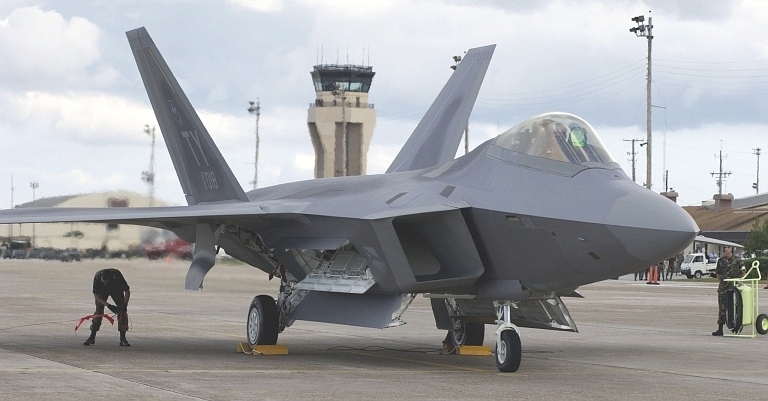 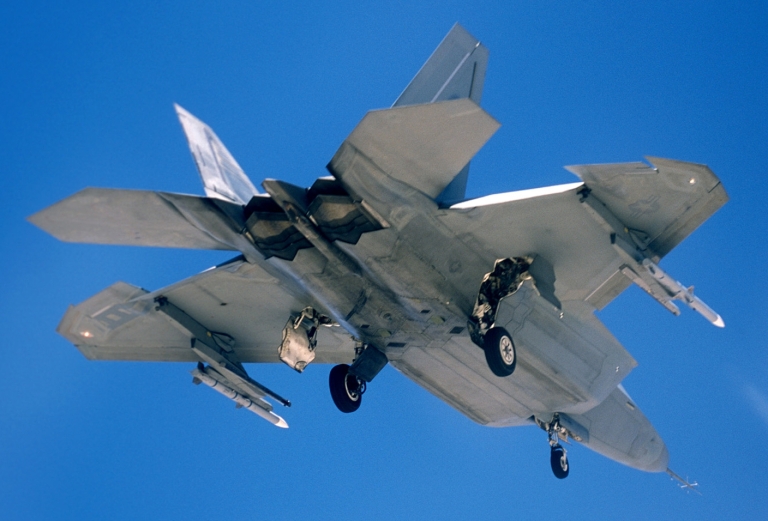 Both the F-22A (above) and the JSF (below) are built to carry weapons internally and if required, externally. Internal carriage is used to achieve full stealth during the opening phase of an air campaign, once opposing defences are broken, larger and more diverse stores can be carried externally. While the JSF matches the internal GBU-39/B payload of the F-22A, it can carry only 75% of the F-22A's external payload. 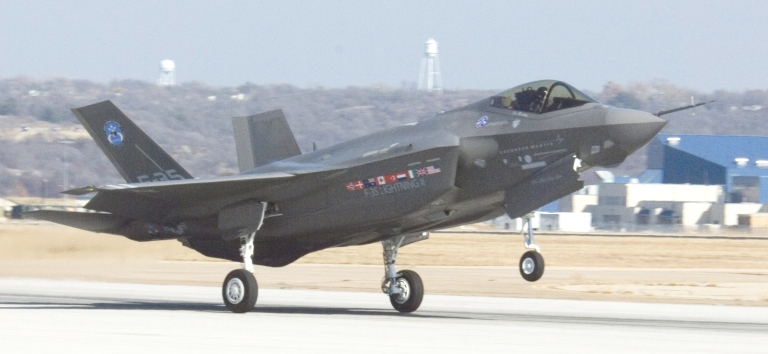 |
|
|
From a simple risk perspective, the much more mature F-22A presents far fewer headaches than the JSF does - both in terms of meeting long term capability needs, and in terms of program stability post 2010. Now operational and in full rate production, most of the initial build of around 186 F-22As will be completed in the 2012 timeframe. Depicted rollout of the first F-22A destined for Elmendorf AFB in Alaska, late 2006.
Risk Factors in
the Joint Strike Fighter Program
The anointed Joint Strike Fighter (JSF) is one of the most technologically ambitious aircraft development programs ever seen, in many respects more ambitious than the TFX program which spawned the F-111. This ambition offers the promise of a battlefield interdiction and close air support fighter intended to have the survivability and lethality well beyond that of the F-16C, A-10A, F/A-18A-D, AV-8B and UK Harriers it is being designed and developed to replace.The flipside of this payoff is that a considerable number of risk factors come into play, potentially affecting costs, timelines and the eventual capabilities that go into the production JSF. For Australia these risk factors combine with the deeper and
more fundamental issues arising from the intended use of a survivable
battlefield interdiction and close air support fighter in the more
challenging roles of 'air dominance fighter' and 'deep strike fighter',
roles which impose their own unique needs on combat aircraft. As cumulative Sukhoi numbers grow across Asia, Australia will
face over coming decades the technologically most competitive region on
the planet, with the statistically newest fleet of third and emergingly
fourth generation fighters in service worldwide in ever increasing
numbers. There can be no doubt the strategy of early commitment to 5th Gen aircraft had its merits as an ambit claim to lock down future defence funds, otherwise likely to be gobbled up by the Army and Navy with their own modernisation needs and agendas. Buying into SDD provided some sectors of Australia's industry, especially in component manufacture, access to a potential market. Australia also gets to sit in on development team meetings, gaining an opportunity to learn much about the issues in the 5th Gen technology base used in the F-22A and JSF. The early commitment strategy however has its drawbacks as
well. The first is that the RAAF must politically defend a massive
burst of single service expenditure in the 2012 to 2020 timeframe -
with early outlays beginning post 2006. In the face of intense
inter-service budgetary competition, other parts of the RAAF are likely
to suffer badly as a result, sacrificed to protect the JSF. To what
extent the F-111 fiasco is a result of this is yet to be known. A
second problem
is the degree of access Australia actually gets by SDD buy-in,
especially in terms of key technology like stealth, engine hot end
technology, AESA radar and software. Briefing slides presented to staff officers with generalist backgrounds are a far cry from immersion in the nitty gritty science and engineering involved. Unless personnel with suitable engineering/science backgrounds and considerable experience are engaged to exploit the gathered data in depth, it may contribute little useful value. The industry benefit may also prove illusory, in that the
highest value added systems integration and software sector of the
industry gets a much smaller bite than the hardware manufacturing
sector, who in turn must compete against overseas peers to retain their
workshare. The worst case outcome - a risk in its own right - is that
the manufacturers end up with very little, the Commonwealth with little
technology transfer, and the RAAF gets stripped to the bone over the
next decade fending off Army and Navy demands for budget. The RAAF has
not competed effectively in the internal budgetary game in recent times
- the 2003 DCP update saw the RAAF lose the F-111 for no gain in
AEW&C, tankers or other 'tier one' assets. The Army gained tier
one Main Battle Tanks, the Navy tier one AAW destroyers, and the
RAAF lost its only 'tier one' combat asset, the F-111. In an increasingly competitive region aiming for a lower capability target in replacing the existing fleet will guarantee an inferior strategic position within a decade, if not sooner. 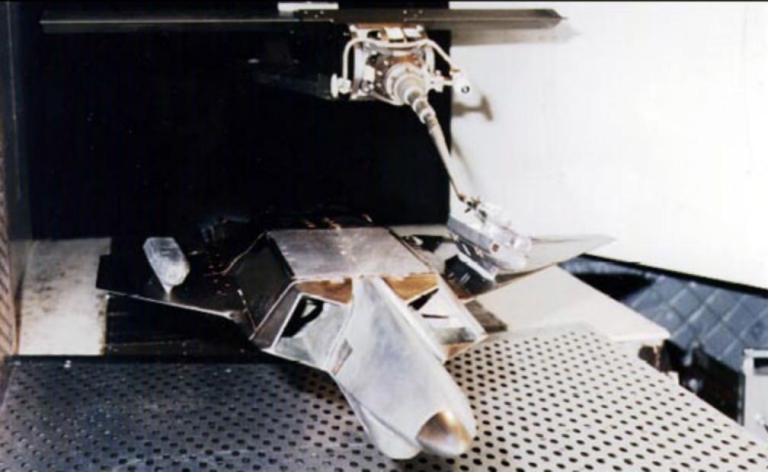 Myths are often
embraced
with religious fervour. One of these
is
that the F-22A is a dedicated and specialised air superiority fighter,
despite the reality that the US Air Force Global Strike Task Force will
use its F-22A component mostly for trucking smart bombs. Depicted (top)
is USAF AEDC wind tunnel testing of a developmental external stores pod
for the F-22A, intended to reduce the radar signature of additional
external bomb payloads. Another myth is that the JSF, in a large part
intended to replace the A-10A and AV-8B Harriers in close air support
roles (bottom), is designed to also fulfil 'air control' or air
dominance roles.
The JSF is the first 'stealth fighter' to be intended for what
is effectively mass export. Production aircraft will likely be
delivered in 'high stealth' (US) and 'low stealth' (export)
configurations, differing in the performance and application of radar
absorbent and lossy materials, as well as 'fully capable' to 'less than
fully capable' variants, such capabilities dictated through the single
source software load. In an environment where every ally is clamouring
for the 'high stealth' model, it might be politically very tricky for
Australia to get access to the full stealth potential of the aircraft.
Given each partner nation is contributing 'risk capital' to varying
degrees to belong to the JSF club, the matter of proprietary rights,
real or implied or inferred, is likely to employ members of the legal
fraternity for decades to come. The stealth capability in the JSF is designed for low cost and maintainability, rather than best possible stealth performance. Stealth is achieved by a combination of shaping, detail design and absorbent/lossy materials, with shaping being the most dominant feature by some degree. While detail design and materials can evolve over the life of a design, and be upgraded incrementally to match an evolving threat, airframe shaping is fixed and whatever limits it imposes are unchangable. The JSF's stealth design is optimised by shaping for the X-band and Ku/K/Ka-bands, which fits the most likely threats US operated JSFs will encounter - highly mobile battlefield air defence weapons and fighter air intercept radars. The serrated nozzle and inlet design reflect this 'narrowband' optimisation - with increasing radar wavelength both will progressively lose effectiveness. The inlet tunnels use S-bending and absorbent materials, while the tailpipe is claimed to use a blocking structure, both most effective in the X-band. The planform and edge alignment is much less disciplined than that in the F-22A or YF-23A, again less critical for an X-band threat confined mostly to the fore/aft sectors. US Air Force thinking is that the JSF is used to demolish battlefield ground targets once the F-22As have broken the back of the IADS and opposing fighter force - in effect the long range S-band, L-band, UHF and VHF radars have been killed off by F-22As, as have the opposing L-band or S-band AEW&C systems. In this environment the greatest risk is presented by opposing fighters hunting with minimal or no GCI support, and mobile AAA and SAM systems like the Roland, Crotale, Rapier, 2K12/9M9 (SA-6), 9K33 (SA-8), 9M37M (SA-11), Tor M1 (SA-15) and ZSU-23-4P. Such SAM/AAA systems typically use the C, X and Ku bands for their search and engagement radars, and X or Ku bands for missile guidance. For such 'shoot and scoot' high mobility short range surface threats and fighter threats the JSF's stealth optimisation will likely work very nicely. For the RAAF who intend to use the JSF to replace the F-111 in
its 'deep strike' (strategic land and maritime strike) role, and
the F/A-18A in the
air combat role, the X-band oriented stealth optimisation of the JSF is
a poor
fit. In both roles this optimisation will frustrate opponents using
X-band engagement and fire control radars, but leaves a major
vulnerability in the lower bands, occupied by static or semi-mobile
early warning, ground control intercept and acquisition radars, as well
as AEW&C radars. The availability of Russian BVR missiles with very
modern infrared seekers and heatseeking adaptations of area defence
SAMs like the HQ-2 and SA-6B presents a situation where the JSF could
be engaged
at a respectable distance, despite its intended good X-band stealth
capability.
Sukhoi Su-27/30 fighters could be vectored into a firing position
without having to light up their X-band radars, or SAM sites cued in a
similar fashion. 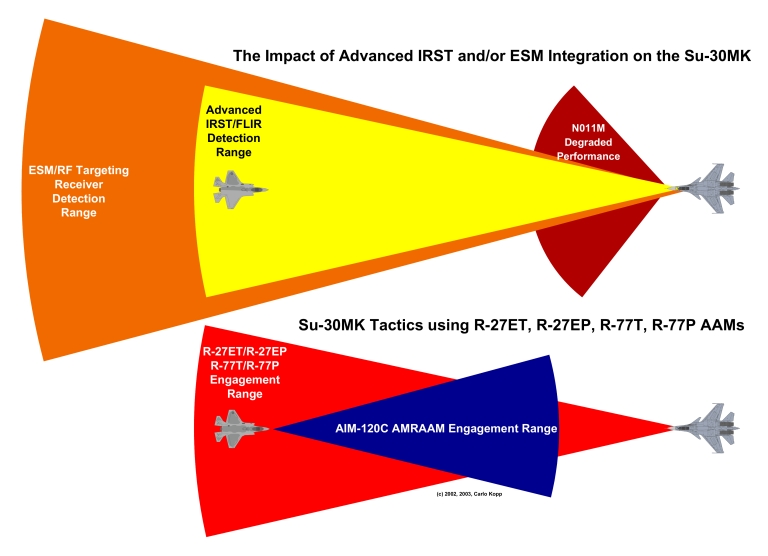
This is the pitfall of economy 'narrowband' stealth - it can defeat upper band radars used for the engagement control, but is much less effective in defeating the long range systems used to acquire targets. If an Su-30 can be positioned close enough, it can engage the JSF regardless of stealth, and with a kinematic and missile performance advantage the odds are unlikely to favour the JSF. While having any real stealth always beats having no stealth, Australia should not develop unrealistically high expectations of the JSF's stealth capability, especially in relation to the principal regional capabilities like the Su-27/30, A-50 AEW&C, S-300/S-400 and supporting long range radar systems. The only fighter optimised for that threat environment at this time is the F-22A Raptor. 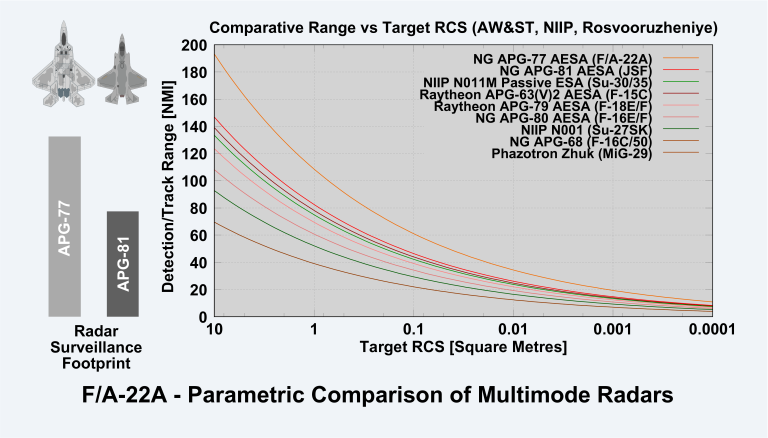 This chart compares publicly available performance figures for a range of current radars, including intended performance for the JSF's APG-81 AESA. While the higher power rating of the JSF radar makes it highly competitive against the older technology passive array in the current Su-30, the introduction later this decade of active array technology in the Sukhoi will tip this balance decisively. The F-22A's APG-77 has an unassailable lead which it will retain longer term (Author).
The JSF builds extensively upon the experience gained with the F-22A's JIAWG (Joint Integrated Avionics Working Group) core avionic system, an implementation of the Pave Pillar model. It is built around three liquid cooled fault tolerant Raytheon Common Integrated Processors (CIP), each originally using a mix of DoD VHSIC custom processors, and i960 chips on SEM-E format modules. The system effectively absorbs all of the processing tasks historically distributed across boxes in the radar, EW equipments, comm/nav equipment, main mission computers and cockpit display processors where used. The aim of this model was to produce a system which could be rapidly upgraded in processing power by the addition or replacement of standardised processing modules, yet providing the ability to flexibly allocate processing power as needed by specific system functions, all implemented in software. The F-22A system set a record for software complexity in a fighter, with around 2.5 million lines of software source code cited. The system departed from the historical use of low speed Mil-Std-1553B busses, using the high speed Fibre Channel-Avionics Environment (FC-AE) serial bus for high speed internal interconnects. The F-22A is the first aircraft to exploit this highly flexible and powerful avionic model, one which is inherently designed to ride on the back of Moore's Law. It has also been the first design to fall foul of processing chip evolution outrunning the system's development cycle, and the sheer complexity of the software creating major delays to production in its own right. The recently redesigned CIP 2000 configuration uses up to 66 COTS based Motorola/IBM PowerPC RISC (ie Apple Mac compatible) and Intel i960MX processor chips and is aimed at cost reduction and supportability, with a follow on upgrade planned to further increase computing power. Since the 'G4' variant, PowerPC chips typically include an embedded 'Altivec' short vector processor which is exceptionally well suited to signal processing tasks, as found in radar, comms and EW processing. The JSF is built around an evolution of the F-22A model, but much more complex in implementation due to the additional, and extensive, electro-optical suite and digital 'soft' cockpit. Its liquid cooled Integrated Core Processors (ICP) are intended to be a cheaper equivalent to the F-22A CIP, relying to a greater extent on COTS packaging technology. Like the F-22A, the JSF is expected to use FC-AE replacing the originally planned IEEE SCI/RT (a commercial flop) in the JAST Pave Pace model, supplemented by IEEE 1394b Firewire bussing (also used in Apple computers) in the Vehicle Management System (VMS). For SDD, the Mercury RACE++ Powerstream processor will be used for signal processing and I/O processing functions - this is a 9U VME format packaged multiprocessor, built around PowerPC RISC processors - essentially a bigger and faster cousin to the 6U VME packaged PowerPC processors now being used in F-15E, F/A-18E/F and F-111C Block C-4. The core avionic system, centred in the ICP and its software, will present some significant development risks. While VME packaged PowerPC hardware is now widely used, it has not been used on the massive scale of the JSF to date. The large number of interconnects, density of hardware, and the demanding thermal cycling and vibration environment has the potential to produce reliability problems, especially of the intermittent variety, in the ICP subsystem. This may not become statistically obvious until a good number of systems are operationally deployed - cyclic wearout problems in printed circuit boards and connectors often resemble the behaviour of airframe fatigue damage and will not manifest until some number of cycles is accrued. The F-22A's Milspec hardened SEM-E packaged system was reported to have had a number of hardware reliability problems, initially misdiagnosed as software faults - the more complex and softer COTS derived ICP has the potential to do the same on a very much larger scale. A less obvious issue for the JSF will be achieving genuine 'open systems' standards compatibility throughout the ICP package and bussing. There will be a temptation to get better performance by using proprietary enhancements to COTS standards, opening a Pandora's box of longer term support issues with single source Silicon and interfaces embedded in the system. Software has proven to be the single biggest headache in the F-22A development program, and the JSF with several times as much is apt to make for several times or more the headache, regardless of lessons learned in the F-22A program. Large realtime systems on multiprocessing computers present some interesting theoretical and practical problems, especially in scheduling computing tasks and guaranteeing shared data consistency and synchronisation - many are considered analytically intractable (the author has both practiced in industry and lectured at university undergraduate and postgraduate level real time software system design, software/systems/hardware reliability engineering, and computer internal architectural design). Sheer complexity is a problem in its own right, typically software bug counts in systems of this complexity increase at a rate faster than the increase in the size of the code, as more software components have opportunities to interact adversely. While cockpit control, radar signal processing, EW processing, comm/nav functions are likely to be less troublesome, the big question will be the bugginess or otherwise of the DAS functions, data fusion functions, and offboard data networking software. Additional difficulties will arise in testing technique to validate the system. Odds are the software will be one of the biggest sources of development cost and time overruns in the latter phase of SDD and LRIP. A related risk factor will be whether Australia is permitted
access to the full software functionality, cf a detuned export variant,
and whether source code and development systems will be provided for
local enhancements and bug fixes to the software. Latest indications
from Fort Worth have all variants of the JSF receiving a single
software load with dynamic software/firmware interfacing and ident
tailoring and codification of the software down to configurable items
on a specific aircraft tail number. The primary sensors, the APG-81 AESA and EOTS present much lesser risks as they ride on the back of the F-22A APG-77, F-16E/F APG-80 and F-16/F-15E Sniper XR programs - the bigger issue for both is long term growth potential. Aperture size in the EOTS will set bounds on growth in long range detection performance. For the AESA, the bigger issue for growth will be the aircraft's cooling capacity - the physics of high linearity RF amplifier design in AESAs result in around 55% or more of the power pumped into the AESA coming out as waste heat via the liquid cooling system. Waste heat management has been an ongoing and frequently reported issue in the JSF program. Significant detection range improvements, or X-band jamming power improvements may well be limited by the aircraft's systems rather than available AESA technology. The narrowband X-band jamming capability planned for the
APG-81 will run
into similar issues as expected with the X-band optimised stealth
capability - most key regional threat systems may sit well outside the
frequency band coverage of the antenna design. As a result any high
power jamming capability the JSF will have will likely be unusable
against the
most likely threats.
The JSF's Electro-Optical Sensor System (EOSS), comprising the ventral Electro-Optical Targeting System (EOTS) and spherical coverage Distributed Aperture System (DAS), coupled via digital processing to the Helmet Mounted Display System (HMDS) and single panel cockpit display, represents the most comprehensive - and complex - electro-optical package ever installed in a combat aircraft. While the EOTS is a repackaged Sniper XR pod derivative, conceptually closest to the F-117A's DLIR/FLIR package, the EO DAS is entirely new. Its aim is to provide spherical day/night IR coverage to facilitate target acquisition and evade threats, especially heatseeking missiles. The EOSS is primarily aimed at close air support and lower altitude battlefield interdiction roles, a result of US Air Force and Marine Corps inputs to this traditionally dangerous regime of operations (LM/CMC/VSI).
Airframe and Propulsion Issues
As with the avionic suite and stealth capability, the airframe and propulsion package of the JSF faces some technological risks in implementation, yet concurrently the role specific optimisations of the design may not mesh well with the much broader range of roles to be performed by the RAAF using JSFs. In terms of the airframe, the biggest development issue will be in containing the empty or basic weight of the aircraft. Excess dead weight will exact penalties in performance, be it agility, range or weapon payload at range. Techniques for reducing excess weight can include reductions in structural weight, at the expense of G-limits or airframe fatigue life, reductions in internal fuel payload at the expense of range/endurance, or reductions in the size of the avionic suite. All essentially amount to reductions in aircraft capability. The alternate path is the use of stronger, more exotic and expensive structural materials to retain capability at the expense of cost. Both the Su-27/30 and F-22A use large amounts of Titanium alloy for this reason. US reports published late in 2003 indicated that a worst case
5,000 lb excess weight had arisen on the STOVL variant design.
Following this announcement, aggressive weight reduction measures under
what was known as the STOVL Weight Attack Team (SWAT) activities
claimed to have slashed 3,400 lb of excess weight. This claim was later
downgraded to what was referred to as the equivalent of a 2,700 lb
reduction in weight of the STOVL variant with commensurate reductions
in weight on the other two aircraft variants - the CTOL and the CV. One
weight saving measure cited was achieved by changing the assembly
technique, at the expense of increased assembly time and cost in
production. Subsequent reports indicate that the design remains around 1,000 lb above intended weight targets. In an interview published in September, 2003, RADM S.L. Enewold, deputy program director of JSF, indicated that weight reductions would be achieved by reducing the performance envelope, ie 'take some corners of the envelope and shave them off'. This is consistent with the Cost As Independent Variable (CAIV) design approach, in which capability is traded down to maintain a target unit cost. For US users of the JSF, who will task it mostly with battlefield interdiction and close air support, reductions in the aircraft's performance envelope, especially speed and agility, will be of marginal relevance - a stealthy equivalent to the F100 powered afterburning A-7 Corsair II interdictor prototype will be more than adequate. If the CTOL JSF ends up a 7.5 G rated, Mach 1.3 dash speed fighter with a SL wet thrust/weight ratio of 0.9:1, the aircraft will still be a major improvement over the types it replaces in this role. An aircraft in this performance bracket will simply not be competitive in air combat roles, in the Asia-Pacific environment of post 2010. To date there have been no unusually adverse reports on the
P&W F135
and GE F136 engines, both using enhanced derivative cores from the
respective F-22A engines, the F119-PW-100 and YF120. Both of these
'supercooled' engines have the hottest running cores to date, even
hotter than the F119-PW-100 which has yet to accrue significant
operational hours. Recent reports do indicate that F135 prototypes are
running hotter than intended, which if not resolved will present longer
term risks. The big issue for the JSF engines will be whether intended durability can be achieved. Not designed for dry supercruise, the JSF will need to use afterburner in combat more frequently than the F-22A, presenting a more aggressive thermal cycling environment. The durability of the F-22A's engine hot end could be a poor indicator of JSF hot end durability. Historically more aggressive operating cycles proved to be a major issue for durability in the hot end of the F-15A and F-16A F100 engine, with a number of hot end fires and written off aircraft. If durability issues arise, they may not become apparent until LRIP aircraft are in early service, and the typical measure to deal with this is derating the engine. This costs top end performance, again a non critical issue for US users, yet a critical problem for Australia. An issue in its own right will be the durability of any stealth coatings used in the nozzle and tailpipe areas. External and especially internal munitions clearances could
also present risks, and problems may not be solved until late in the
program. The drag increasing pylon toe-out in the F/A-18E/F presents a
good example. Internal release of smaller weapons like the GBU-39/B or
GBU-38 500 lb JDAM can be challenging, as ejection velocities in excess
of 20 ft/sec could be required. While the use of pneumatic ejectors
will address this for the basic payload of 8 x GBU-39/B, growth
configurations may present genuine problems. A major concern at this time is that the JSF Threshold Weapons
List has been significantly reduced in size since 2003, pushing many
weapon clearances into the production rather than SDD phase. If
aggressive design changes are required, either very high expenses will
be incurred or specific weapon types abandoned.
The technological
design
features of a fighter can be divided
by the
rate at which they evolve over time. The smartest long term choices are
always those which put the highest priority on design features which
cannot be altered once the aircraft is in service, accepting that
rapidly changing technologies will be replaced over the life of the
aircraft. The most attractive aspects of the JSF are all in areas which
rapidly evolve, whereas its least attractive aspects are in areas which
cannot evolve. From a technological strategy perspective the JSF is a
very poor choice long term compared to the F-22A (Author).
For Australia another key long term issue will be the growth potential of the JSF design. Additional engine thrust for a given core technology is usually achieved by increasing engine massflow - informed sources indicate the current inlet design has only a very modest growth margin in available massflow. Whether a 50,000 lb class F135/F136 derivative can be used with this inlet has not been disclosed to date. Another growth issue will be available internal volume for avionics, and especially waste heat management capacity. Any increases in ICP capacity and AESA power rating will be reflected in significantly greater waste heat to be dumped from the systems, already reported to be an issue at this stage. Again, for US users targeting interdiction and support roles avionic growth limits may be largely irrelevant - more radar range and a larger information gathering footprint are not critical factors. For Australia, competing with Sukhoi growth in air combat roles, and using the JSF to provide ISR and long range strike capabilities, growth will be a decisive issue. The design of the EOTS window fairing and nose radomes will impose hard limits on any aperture size growth in these key sensors, in turn setting bounds on achievable sensitivity growth. This is especially a problem for advanced IRST capabilities, which require also an expensive replacement of the Sapphire windows with a longwave transmissive material. There are many as yet unresolved technological risks in the
JSF, and many of these may not be manifested until later this decade
or, with slippages in the integrated flight test program, early in the
next decade - potentially impairing the performance of the JSF in
precisely those areas where Australia needs to be highly competitive
longer term.
Build Numbers, Timelines and Costs
Other major risks will arise in relation to build numbers, delivery timelines and costs. We have already observed a 12 month delay introduced into the program to manage risks, while US$5B was shifted from the LRIP budget into the development budget late 2003. While full scale production is almost a decade away, any schedule slippages will impact production costs. Flyaway costs of aircraft are highest at the start of full scale production, and progressively reduce as cumulative build numbers accrue, production investment is amortised, and component manufacture matures. Current Defence planning sees Phase 1/2 JSF deliveries starting around 2012 and ending later that decade. If the JSF production schedule is delayed significantly, Australia buys more expensive JSFs sitting earlier on the production cost curve. In plain dollar terms, buying JSFs in 2020 is cheaper than buying them in 2012. Cost related risks fall into three broad categories. The first is that resolution of technological problems drives up the build cost. The second is that schedule delays put any Australian buy into an earlier portion of the cost curve, assuming current planning schedules for F/A-18A replacement. The third is that US and export clients buy lesser numbers. The third is potentially the most problematic, as it is driven
by overseas budgetary politics and evolving strategic needs. It could
manifest itself very late in the program. Since Australia joined SDD we
have seen the US Navy and Marines trim back their buys, with the
current total sitting around 2,500 aircraft. Only the Marines and the
UK are technologically locked into the JSF as they use STOVL carriers.
The US Navy could bail out and buy more F/A-18E/Fs if the going gets
too tough for them at any stage. The early February, 2007, release of US budgetary figures saw
this risk materialise, with a constrained US budgetary environment
forcing a reduction in the sustained JSF production rate from 110
aircraft annually to 48 annually, for the US Air Force. While the US
Air Force would like to buy 1763 aircraft, it is capped by the budget
to a figure, which if these restrictions are sustained, will be around
720 aircraft in total. Shifting strategic needs over the longer term could have the
greatest impact on US
Air Force numbers, as their targeting model is reoriented from
predominantly static to mostly mobile ground targets. Even at the JSF's
nominal 600 NMI radius, a lot of tanking is required to achieve
significant persistence. An F-111 sized FB-22A works much better as a
battlefield interdiction asset than a JSF does, and if the FB-22A does
materialise it will subsume over time much of the battlefield
interdiction role, driving the JSF into the specialised lower altitude
close air support role which it is superbly adapted to. As the Quadrennial Defence Review early in 2006 indicated, encroachment on the core JSF battlefield interdiction role by other platforms is an ongoing issue. As yet an unknown is the pricing and numbers impact arising from any move by the US Air Force aimed at splitting its JSF buy into CTOL and STOVL variants - a proposal revived by SecAF James Roche at the 2004 AFA (Air Force Association) symposium in the US and intended to bolster CAS/BAI strength in expeditionary forces. If this occurs, build numbers of CTOL JSF go down further driving up flyaway costs, and build numbers of STOVL go up, driving down flyaway costs. Out of a finite budget a smaller total number of JSFs is bought for the US Air Force, in turn impacting flyaway costs across all three variants. The US Air Force started hedging its bets on JSF timelines by planning engine and avionic upgrades, and wing structural rebuilds, for most of the A-10As in their fleet, in 2004, upgrading them to A-10Cs with improved avionics, new cockpit, HOTAS system, upgraded electrical power capacity, new low level NAV/Targeting capabilities, MIL-1760 weapons bus upgrade, capability to carry electro-optical targeting pods and the latest 'J' series weapons. Long term export numbers for the JSF remain unclear. Many EU
F-16 operators will simply opt to swap their existing fleets for
incrementally better JSFs, in a truly benign post Soviet local
strategic environment. With the cost increases resulting from the
reduced US Air Force build rate, we might see partner nations bailing
out, and will see reductions in buy sizes to fit within constrained
national defence budgets.
With similar internal
fuel
loads in production models
(differing
from demonstrators), the larger but cleaner F-22A provides similar
combat radius to the JSF. Both types will suffer combat radius loss
with draggy external payloads, and both types require extensive aerial
refuelling support to compete with the existing F-111 in both
range/payload and on station persistence.
What Next for Australia?
The Defence leadership's interest in using the JSF for air control / air dominance roles, and long range strike roles, does not fit well with the basic design optimisations of the JSF, or the outcome of likely CAIV driven downstream performance/cost tradeoffs in the JSF program. In distant historical terms it is akin to using a P-40 to do the jobs of a Beaufighter and P-38. In its core role of 'classical' battlefield interdiction and close air support, the production JSF is apt to be a superb performer, more lethal and survivable than the F-16C, F/A-18A-D, A-10A and AV-8B it replaces. Its effectiveness in the air combat role, against the ever evolving capabilities of the Sukhoi fighters and newer Russian missiles, is very much open to debate and clearly problematic. In the long range strike role, around 60 JSFs with generous tanking could match the aggregate punch of the existing F-111 fleet, but the 'narrowband' stealth optimisations of the design will not provide the kind of unchallenged survivable deep strike capability Australia gained in 1973 with the F-111, pitted against then available regional capabilities. The big question for Australia is whether the JSF is suitable
as a single type replacement for the F/A-18A and F-111. Aside from the
fractional battlefield interdiction and close air support roles, the
JSF falls well short in the prime air control and deep strike roles,
compared to the alternative F-22A and likely future FB-22A. The JSF is
clearly no match for the F-111 as a basic 'bomb truck'. Even from an early stage in the NACC/AIR 6000 program
an overwhelming case could be made for restructuring the program to
focus
on
the F-22A rather than JSF, with a decision deferred past 2008. While
the
F-22A was slightly more expensive, it is also more mature and much more
capable
permitting smaller numbers to achieve better combat effect. A package
of 36 F-22As is more lethal and survivable than a package of 72 JSFs,
especially in the critical air control and deep strike roles. An 'F-22A-centric' NACC solution involves a mature production
fighter
after 2010 and incurs none of the schedule, technology and cost
structure risks, or longer term strategic and technological risks
associated with the JSF - an 'F-22A-centric' NACC is a very safe
solution, strategically, fiscally and politically. The current plan for early retirement of the F-111 is particularly unhelpful in terms of providing long term options for the NACC program. Retention of the F-111s past 2020 would permit spreading the expense of F-22A, JSF or mixed buys over a longer timeline, without any capability gaps arising. The current plan simply forces the replacement buys into an earlier and more expensive time window, while incurring a large capability gap and wastage of prior taxpayer's investment. Indeed, the cost disparity between Australian Industry proposals for an F-22A/F-111 force mix, against the current Defence plan centred in the expensive rebarrelling of the F/A-18A/B HUG fleet, acquisition of F/A-18F 'interim fighters' and later the JSF, is over A$11 billion - in favour of the Industry Proposal - and rising as long standing, previously identified risks materialise in the HUG and JSF programs. The intended acquisition of F/A-18F 'interim fighters' simply
offsets the reduced availability of the F/A-18A/B HUG fleet resulting
from increasing downtime of aircraft due to structural rebuilds and
does not result in recovering any of the capability lost through
premature and unwarranted F-111 retirement. The stark reality is that whatever aircraft is chosen by the then incumbent Defence leadership group, Australia will have to live with it into the 2040 to 2050 timescale. Choices which might look just good enough against the region today will not be competitive within the decade let alone two to three decades hence, as a wealthier Asia invests increasingly in modern air power. The current JSF-centric plan for the RAAF's future is simply not good enough, and the band-aid acquisition of the F/A-18F Super Hornet only exacerbates its problems. |
|
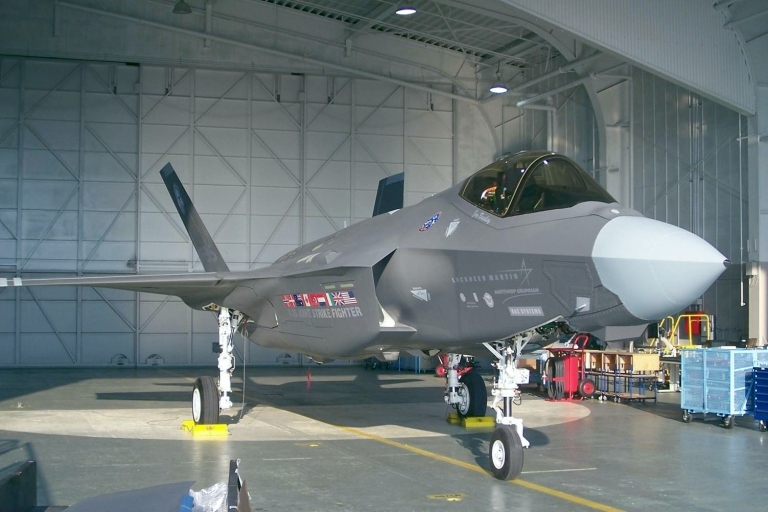 |
|
Imagery Sources: US Air Force, Author Line Artwork: © 2005, 2007 Carlo Kopp |
|
|
Technical Report APA-TR-2007-0102 |
|
|
|||||||||||||
![Sukhoi PAK-FA and Flanker Index Page [Click for more ...]](APA/flanker.png) |
![F-35 Joint Strike Fighter Index Page [Click for more ...]](APA/jsf.png) |
![Weapons Technology Index Page [Click for more ...]](APA/weps.png) |
![News and Media Related Material Index Page [Click for more ...]](APA/media.png) |
||||||||||
![Surface to Air Missile Systems / Integrated Air Defence Systems Index Page [Click for more ...]](APA/sams-iads.png) |
![Ballistic Missiles and Missile Defence Page [Click for more ...]](APA/msls-bmd.png) |
![Air Power and National Military Strategy Index Page [Click for more ...]](APA/strategy.png) |
![Military Aviation Historical Topics Index Page [Click for more ...]](APA/history.png)
|
![Information Warfare / Operations and Electronic Warfare Index Page [Click for more ...]](APA/iw.png) |
![Systems and Basic Technology Index Page [Click for more ...]](APA/technology.png) |
![Related Links Index Page [Click for more ...]](APA/links.png) |
|||||||
![Homepage of Australia's First Online Journal Covering Air Power Issues (ISSN 1832-2433) [Click for more ...]](APA/apa-analyses.png) |
|||||||||||||
| Artwork, graphic design, layout and text © 2004 - 2014 Carlo Kopp; Text © 2004 - 2014 Peter Goon; All rights reserved. Recommended browsers. Contact webmaster. Site navigation hints. Current hot topics. | |||||||||||||
|
Site Update
Status:
$Revision: 1.753 $
Site History: Notices
and
Updates / NLA Pandora Archive
|
|||||||||||||
|
|
Tweet | Follow @APA_Updates | |||||||||||
|
|
|||||||||||||
|
|
|||||||||||||
![F-111 Aardvark Index Page [Click for more ...]](APA/f-111.png)
![F/A-18 Hornet and Super Hornet Index Page [Click for more ...]](APA/fa-18a.png)
![Aerial Refuelling and Airlift Capabilities Index Page [Click for more ...]](APA/aar-lift.png)
![Directed Energy Weapons and Electromagnetic Bombs Index Page [Click for more ...]](APA/dew.png)
![Notices and Updates Index Page [Click for more ...]](APA/notices-128.png)
![APA NOTAM and Media Release Index Page [Click for more ...]](APA/notams-128.png)
![APA Research Activities and Policy / Technical Reports Index [Click for more ...]](APA/research-128.png)
![Search Air Power Australia Website [Click for more ...]](APA/search-128.png)
![Briefings and Submissions - Air Power Australia [Click for more ...]](APA/briefs-128.png)
![Air Power Australia Contacts [Click for more ...]](APA/contacts-128.png)
![Funding Air Power Australia [Click for more ...]](APA/funding-258.png)
